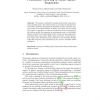2116 search results - page 76 / 424 » On Probabilistic Alternating Simulations |
106
click to vote
ADMI
2010
Springer
14 years 11 months ago
2010
Springer
Abstract. We present a method for learning characteristic motion patterns of mobile agents. The method works on two levels. On the first level, it uses the expectation-maximization...
109
click to vote
ANTSW
2010
Springer
14 years 8 months ago
2010
Springer
Robot swarms provide a way for a number of simple robots to work together to carry out a task. While swarms have been found to be adaptable, fault-tolerant and widely applicable, d...
CDC
2009
IEEE
14 years 7 months ago
2009
IEEE
We consider the problem of controlling a continuous-time linear stochastic system from a specification given as a Linear Temporal Logic (LTL) formula over a set of linear predicate...
ICRA
2010
IEEE
14 years 7 months ago
2010
IEEE
This paper presents an EKF-based approach to the problem of robot formation pose tracking in SLAM when a previously built feature-based stochastic map of a navigation area is avail...
ESA
2009
Springer
15 years 2 months ago
2009
Springer
A familiar quandary arises when there are several possible alternatives for the solution of a problem, but no way of knowing which, if any, are viable for a particular problem inst...

